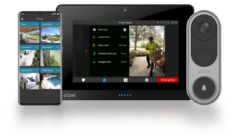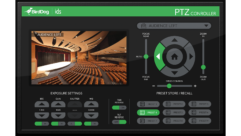
Technology Showcase: PTZ Security Cameras
Feb 1, 2008 12:00 PM,
By Jay Ankeney
There is no hiding the innovations in remotely controlled video surveillance cameras.

Bosch Security 300 Series PTZ
Most of us grew up under the nightmare tutelage of George Orwell’s famous novel 1984, which warned us of the dangers of constant surveillance. Yet the events of recent years have made us reconsider the potential advantages of having someone watching over us — especially in potentially dangerous surroundings.
Today, the presence of surveillance cameras can bring the assurance that someone, somewhere will at least be alerted in case of trouble — if not actually come to our aid. In addition, having an unblinking electronic eye overhead is one of the most powerful deterrents to both theft and intrusion. Truly, being under someone’s watchful surveillance has become part of our existence — and as long as that observation does not become part of a massive control organization run by a ubiquitous governmental Big Brother, most of us are resigned to its eternal vigilance.
As a result, the installation of remotely monitored and controlled surveillance cameras, known to the AV industry as pan, tilt, and zoom (PTZ) cameras, has become a rapidly burgeoning business. Often referred to as a network camera or an IP camera because of its connectivity, a remotely controlled PTZ camera system combines an analog — or more commonly digital — camera mounted on a motorized control head with communication capabilities to a remote-monitoring site, and it features either automated or humanly directed control and observation capabilities.
The market research firm Frost & Sullivan estimates the network video surveillance camera market in North America alone will grow from more than $200 million in 2008 to more than $800 million by 2012.

Canon VB-C300 PTZ
Recent trends have given these cameras, usually mounted in protective domes, the ability to pan up to 360 degrees and move at varying speeds. Equipped with full-color imaging sensors for daytime operation, they can see in the dark with the help of removable infrared filters, and they incorporate sophisticated motion-sensing technologies that can detect when an object enters or is removed from the scene.
Control technologies are available from many of the PTZ camera manufacturers themselves. There are also third-party software packages from other vendors that often provide additional functions and access to dozens of cameras by multiple operators. The front-end user interface for a PTZ camera can range from a dedicated control console to the up/down/left/right arrows on a digital video recorder or a joystick on a keyboard connected to the Internet. Many have built-in motion and/or object-recognition capabilities to help detect activity in their coverage. Most systems can be programmed to scan a repeatable tour of specific preset areas, while also intentionally not observing other zones the operators have determined to be off limits.
The reach of PTZ cameras has also been extended with improved optical-zoom lenses reaching out up to 36X — and even that can be vastly extended to the point of pixelation with the addition of digital zoom technology. Several of these zoom lenses provide extra-wide-angle views in addition to increased telephoto range, and new-image digital signal processing (DSP) stabilization algorithms help make those pictures discernable even at maximum zoom. An increasingly common feature is some form of 180-degree autoflip that inverts the image if an object’s course moves underneath the camera and passes by. That way, the operator doesn’t have to stand on his or her head to identify the image as it rotates through the scene.
Some models also have the capability of picking up sounds from their local environment, and they can be loaded with prerecorded verbal warnings that can be broadcast in case an outsider invades their field of observation. That’s why visitors to London often report hearing a disembodied voice from above if they have parked in a forbidden zone.
The domes that house these cameras are often heated and cooled internally to protect the cameras’ electronics, and their ability to withstand the elements is specified by Ingress Protection (another use of “IP”) ratings that have been developed by the European Committee for Electrotechnical Standardization. An IP rating normally has two or three numbers: The first indicates protection from solid materials (dust and dirt); the second relates to protection from liquids (rain or direct sprays); and the third reflects protection against mechanical impacts (dropping the dome or whacking it with a baseball bat). Because the last is pretty hard to determine — and not always flattering to the manufacturer — it is often omitted. The higher the number, the better, so a dome with a rating of IP66 should ensure protection against the threat of blowing dust and high-pressure water jets from any direction.
This would all be useless, of course, if these surveillance cameras couldn’t send out some kind of call to action. Although this technology started in the analog era — with cameras distributing their surveillance vision over coaxial, unshielded twisted-pair (UTP), or fiber-optic cable — today, most of the latest models of these surveillance cameras are digital, and they have built-in web browsers. That way, they can send their messages over the Internet using a TCP/IP network to anywhere in the world, letting IP operators globally oversee their operational status and observe any activities that seem out of place. These days, a remotely controlled digital PTZ camera can phone home with warning alarms, text messages, Wi-Fi calls for help over IEEE 802.11g to a PDA, or specifically targeted email alerts over the Internet.
Internet Protocol (returning to the more common use of “IP”) has enabled these remotely controlled PTZ cameras to be monitored and directed from anywhere with web access. The downside of IP connectivity can be a delay in sending the video packets across a network unless the system has a very large bandwidth capability. Recent improvements in compression technology, such the H.264 version of MPEG-4, have greatly increased the immediacy of these cameras’ communication, and they are being adopted more frequently.
Technology Showcase: PTZ Security Cameras
Feb 1, 2008 12:00 PM,
By Jay Ankeney
There is no hiding the innovations in remotely controlled video surveillance cameras.

Elmo PTC-401C IP
Here is a look at some of the latest innovations in remotely controlled PTZ surveillance cameras.
The AutoDome Easy PTZ camera from Bosch Security combines a high-performance pan/tilt unit and a state-of-the-art autofocus zoom camera into a single compact mini-dome housing that is less than 4in. in diameter. That’s 20 percent smaller than most mini domes, yet it still offers variable pan-and-tilt speeds and autopivot to ensure optimal camera control and viewing at all zoom levels. The AutoDome Easy PTZ camera’s 100X (10X optical/10X digital) zoom can be used with 60 user-defined presets, four preset tours, and multiple autoscan modes. The Bosch AutoDome 300 series high-speed PTZ dome camera system boasts optional hybrid operation for simultaneous analog (coax) and IP (MPEG-4) connectivity, and its AutoDome 500i series intelligent PTZ camera system provides fully interchangeable CPUs, cameras, housings, communications, and mounts. The 500i series also incorporates intelligent features such as motion detection and Auto Track II automated motion-tracking technology.
The VB-C300 PTZ camera from Canon builds on the high-quality video monitoring products from the Canon Network Video Solutions assortment. Thanks to its70-degree Canon AF wide-angle lens, the VB-C300 is primarily designed for installations for which monitoring tight spaces is paramount, although it also has a 2.4X optical zoom and 4X digital zoom. A mechanical IR cut filter gives the VB-C300 auto day/night capability enhanced by Canon’s proprietary image-processing technology. The VB-C300 PTZ also offers Power over Ethernet (PoE), and it comes with a built-in network server for high-performance data transmission. In addition, Canon VB-C50i and reverse-mounted VB-C50iR PTZ camera systems deliver clear video from far distances under the dimmest lighting conditions — often beyond the scope of the human eye. The VB-C50i andVB-C50iR now also have two-way audio capability, along with teleconferencing and web-casting options.
The Altitude 9840 series of high-resolution network-based video and audio PTZ dome cameras with 35X optical zoom are DVTel‘s latest addition to its line of MPEG-4, 4CIF-based IP network cameras. With IGMP snooping technology, the cameras enable a single stream to be transmitted to multiple viewers on a network simultaneously while reducing bandwidth demands. The Latitude Network Video Management System’s Digital Virtual Matrix Switch allows independent settings for live video and recorded streams. This lets an authorized user observe the viewing stream while the recording stream is being captured on the Latitude Media Archive Server storage system. The DVTel Altitude 9840 IP dome-camera system also provides bidirectional audio and data.

GE Security Legend IP
From Elmo comes the PTC-401C IP, which allows full PTZ control via a web browser over LAN/WAN. The camera can be controlled with a remote joystick/controller or through control outputs from a DVR generated by mouse and onscreen GUI. The remote PTZ functions can be managed wirelessly or through RS-485 (standard for security) or RS-232 (standard for AV markets). Elmo’s own software application provides single-camera control of the PTC-401C IP, including image flip. Third-party software control can also include target tracking that directs the PTZ functions without human intervention to keep the camera aimed at a moving target that meets certain user-defined criteria. That way, an intruder can be kept in the field of view while help is being notified.
The newest addition to the GE Security integrated-network dome-camera line is Legend IP with a built-in MPEG-4 video encoder that provides D1 resolution at a full 30fps over a 10/100Base-T Ethernet network. A choice of 36X or 26X optical zoom lenses with 12X digital zoom assist gives the Legend IP dome camera 432X or 312X total zoom. Sixteen shadow tours can hold a total of 20 minutes of pan, tilt, and zoom operation. Each of the 127 preset positions in the Legend IP stores the pan, tilt, and zoom position along with a complete list of camera settings including backlight compensation, iris, and shutter settings. The GE Legend IP also features SilkTrak direct drive for smooth and precise PTZ movement.
The new Honeywell Security Acuix PTZ speed dome camera will be available in March. The company is calling it “round-the-clock viewing that never blinks.” Using up to 35X zoom lenses with image stabilization, the Acuix allows an operator to download and save all camera and location-specific settings including labels, presets, tours, and privacy zones in its dedicated remote DVR or on disk in a secure location. The Acuix system will feature Honeywell’s exclusive IntelliBus bidirectional communication protocol with dynamic privacy zones that allow programming 32 areas with restricted viewing. The Honeywell Security Acuix PTZ speed dome camera comes with a variety of housings for enhanced security and aesthetic appeal.
The IPD-Q38 IP network PTZ dome camera from Ikegami outputs JPEG2000 images with wavelet transformation for improved still-frame clarity, and it boasts a 35X optical zoom. Its PTZ mount has a 500-degree-per-second pan speed and a minimum illumination of 1 lux/f1.4. The pre-alarm function of the IPD-Q38 records images that have been shot before an alarm is sounded, while alerts are sent to a designated email address. Ikegami’s motion detector is designed to disregard disturbances, such as tree leaves swaying in the wind, to minimize false alarms. The whole system’s software can be updated and self-diagnosed over the network for realtime maintenance, and it can work with multiple protocols including TCP/IP, SMTP, POP3, DHCP, and HTTP.
Just last November, JVC released its new VN-V686WPU outdoor PTZ dome camera. This month, that should be joined by the company’s VN-V686U indoor model. Both ensure the accuracy of their pan/tilt positioning with a silent direct-drive motor mechanism. Each offers motion detection, auto tracking, image stabilizer, and private masking, and easy installation and maintenance with a one-touch lock mechanism that separates the camera from its head for quick replacement. The JVC VN-V686 line has a memory-card slot (CF card), web and FTP-server functions, and 100 preset positions. JVC claims its PTZ cameras are both the fastest and the slowest on the market, rotating at 400 degrees per second to complete a full circle in less than one second, or crawling around at .01 degrees per second for extremely slow pans. For use in extreme environments, the VN-V686 PTZ cameras can operate at temperatures down to -40 degrees F.
Last year, Panasonic Security Systems enhanced its line of i-Pro intelligent network products with several new models, including its WV-NW964 weatherproof outdoor network PTZ with SDIII technology. That SDIII technology delivers the highest-quality images attainable in any lighting condition along with a host of features including dual-stream MPEG-4/JPEG output, an SD memory-card slot for onboard recording, autotracking, 256 preset functions, and super-slow and fine manual PTZ movement — along with high-speed movement for mission-critical object-tracking operations. IP66-rated, the WV-NW964 boasts endless PTZ operation for superior picture quality with no digital-to-analog-to-digital conversion.

Samsung SPD-3300
As one of the largest manufacturers of PTZ cameras, Pelco makes models for every application from indoor school settings to explosion-proof domes. From its Spectra Mini, which it touts as the smallest-form-factor positioning system available, to the Spectra IV 35X SE, Pelco offers a wide range of systems delivering PTZ control. Spectra 14 offers autofocus on a high-resolution integrated color camera/optics package with zone blanking, 64 presets, and a 140-degree-per-second pan speed. The Spectra Mini incorporates many well-known features from the company’s full-size Spectra dome systems into a cost-effective small form factor. Its high-resolution camera transmits video over coaxial cable or unshielded-twisted-pair wires, and its pan/tilt operation with onscreen programming can be performed with Pelco controllers, which transmit D, P, or Coaxitron protocols. Pelco PTZ dome systems come with quick-connect cables for power, video (coax or UTP), and data.
Samsung Super Noise Reduction (SSNR) virtually eliminates noise in low-light situations for the SPD-3300, along with providing a DVR storage savings of up to 70 percent. It offers privacy masking, motion detection, digital flip, and 128 presets — all accessible through an onscreen display. The SPD-3300 comes with a 30X optical zoom, 8X digital zoom, and 126X wide dynamic range, and its output is MPEG-4 or JPEG-selectable. With a pan angle of 360 degrees, the SDP-3300 can rotate completely around on its horizontal axis wile providing a tilt angle of -4 degrees to 184 degrees. The SPD-3300 features a 1/4in. color vertical double-density interline CCD, static/dynamic IP support, 0.0006 lux minimum illumination, bidirectional audio, 128 position presets, and FTP/email notification.
The newest entry in Sony‘s third generation of PTZ dome cameras is the SNC-RX570, incorporating the latest image-processing technology to provide multiple compression formats. It features a 360-degree endless-panning capability, a 36X optical-zoom lens, and a wide-dynamic-range camera. The SNC-RX570 has the same dual-streaming capability as the previous SNC-RZ50N, enabling the camera to generate both MPEG-4 and JPEG images simultaneously, and it features Sony’s version of Intelligent Motion Detection. Unlike conventional motion detection, which typically detects luminance level differences, the SNC-RX570 uses the last 15 frames to calculate vector-based motion-detection information. It also has intelligent object detection, which can detect objects that have been left in one place for a specified duration. With an optional 802.11g Wi-Fi card, theSNC-RX570 can transmit its signals, both wired and wireless, simultaneously.
The Vicon SurveyorVFT IP dome camera series started out standing for “video, fiber, twisted pair” to emphasize its connectivity options. That means the SurveyorVFT PTZ camera can communicate over any of those transmission protocols simply by swapping out its daughterboard, and that is in addition to IP. With a motorized pan view of 360 degrees and tilt view of -2.5 degrees to 92.5 degrees, the SurveyorVFT has a variable tilt speed from 0.1 degree per second to 150 degrees per second, and it offers 79 programmable presets. This PTZ system comes with vandal-resistant and +5 PSI pressurized housings for the most challenging installations. SurveyorVFT can be remotely configured from Kollector Elite recorders and ViconNet NVR workstations. The ViconNet dome uses an MD5-type video-authentication algorithm, which is based on a 128-bit message used to identify data integrity.
Videology says its IP66-rated, vandal-resistant DW5V9TVB-1 outdoor dome is “tough yet elegant,” while boasting a true day/night high-res color Sony CCD behind a 22X optical zoom (10X digital) lens system. This versatile dome housing can also accommodate a wide-dynamic-range camera. Using endless 360-degree pan rotation with autoflip and 127 preset positions, the DW5V9TVB-1 comes with a focus-lock preset option to optimize night imaging. Videology’s latest is the cost-efficient 20Z704T-PZ, also with 22X optical zoom. The 20Z704T-PZ has low-light capability of 1 lux during the day and .001 lux at night with digital slow shutter and eight swing speeds. It copies and saves its pan/tilt movement (one direction) for repetitive viewing.
The VT-PTZ36 Xpress Dome PTZ with 36X optical zoom from Vitek is a true day/night camera that can record an image even under candlelight (0.01 lux night mode w/ICR on). The system comes with a built-in 3.4mm-to-122.4mm lens with 36X optical zoom and 12X digital zoom. It can be programmed with eight tours — with each tour consisting of up to 64 presets, patterns, scans, and other tours. It is capable of 248 presets programmed with view direction and zoom. There can be eight privacy zones including “video off” or up to eight masked blocks. The Vitek VT-PTZ36 Xpress Dome PTZ offers 64 steps of variable speed from 0.1 degree per second to 90 degrees per second with a minimum adjustable angle of 0.0375 degrees using its Single Step move function. At the other end of its traversing range, the camera’s maximum manual speed is 360 degrees per second with the Turbo key pressed.
For More Information
Bosch Security
www.boschsecurity.us
Canon
www.usa.canon.com
DVTel
www.dvtel.com
Elmo
www.elmousa.com
GE Security
www.gesecurity.com
Honeywell Security
www.honeywellsecurity.com
Ikegami
www.ikegami.com
JVC
pro.jvc.com
Panasonic Security Systems
www.panasonic.com/business/security
Pelco
www.pelco.com
Samsung
www.samsung360.com
Vicon
www.vicon-cctv.com
Videology
www.videologyinc.com
Vitek
www.vitekcctv.com










